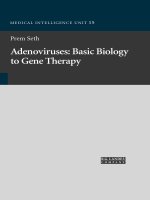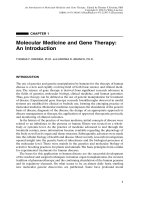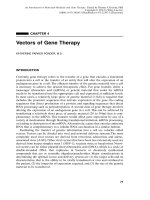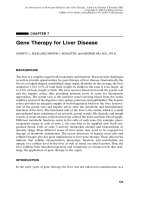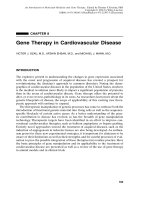adenoviruses. basic biology to gene therapy
Bạn đang xem bản rút gọn của tài liệu. Xem và tải ngay bản đầy đủ của tài liệu tại đây (3.8 MB, 334 trang )
MEDICAL INTELLIGENCE UNIT
15
Prem Seth
Adenoviruses: Basic Biology
to Gene Therapy
R.G. LANDES
C OM PA N Y
MEDICAL
INTELLIGENCE
UNIT 15
Adenoviruses: Basic Biology
to Gene Therapy
Prem Seth, Ph.D.
Human Gene Therapy Research Institute
Des Moines, Iowa, U.S.A.
and
Medicine Branch
National Cancer Institute
National Institutes of Health
Bethesda, Maryland, U.S.A.
R.G. LANDES
COMPANY
AUSTIN, TEXAS
U.S.A.
MEDICAL INTELLIGENCE UNIT
Adenoviruses: Basic Biology to Gene Therapy
R.G. LANDES COMPANY
Austin, Texas, U.S.A.
Copyright ©1999 R.G. Landes Company
All rights reserved.
No part of this book may be reproduced or transmitted in any form or by any means,
electronic or mechanical, including photocopy, recording, or any information storage and
retrieval system, without permission in writing from the publisher.
Printed in the U.S.A.
Please address all inquiries to the Publishers:
R.G. Landes Company, 810 South Church Street, Georgetown, Texas, U.S.A. 78626
Phone: 512/ 863 7762; FAX: 512/ 863 0081
ISBN: 1-57059-584-4
While the authors, editors and publisher believe that drug selection and dosage and the specifications and usage of equipment and devices, as set forth in this book, are in accord with current
recommendations and practice at the time of publication, they make no warranty, expressed or
implied, with respect to material described in this book. In view of the ongoing research, equipment
development, changes in governmental regulations and the rapid accumulation of information
relating to the biomedical sciences, the reader is urged to carefully review and evaluate the information provided herein.
Library of Congress Cataloging-in-Publication Data
Adenoviruses: basic biology to gene therapy / [edited by] Prem Seth.
p. cm. -- (Medical intelligence unit)
Includes bibliographical references and index
ISBN 1-57059-584-4(alk. paper)
1. Adenoviruses. 2. Genetic vectors. 3. Gene therapy. I. Seth,
Prem, II. Series.
[DNLM: 1. Adenoviridae. 2. Gene Therapy -- methods. 3. Genetic
Vectors.
QW 165.5.A3 A2323 1999]
QR396.A343 1999
579.2'443 -- dc21
DNLM/DLC
99-32566
for Library of Congress
CIP
PUBLISHER’S NOTE
Landes Bioscience produces books in six Intelligence Unit series:
Medical, Molecular Biology, Neuroscience, Tissue Engineering,
Biotechnology and Environmental. The authors of our books are
acknowledged leaders in their fields. Topics are unique; almost
without exception, no similar books exist on these topics.
Our goal is to publish books in important and rapidly changing
areas of bioscience for sophisticated researchers and clinicians. To
achieve this goal, we have accelerated our publishing program to
conform to the fast pace at which information grows in bioscience.
Most of our books are published within 90 to 120 days of receipt of
the manuscript. We would like to thank our readers for their
continuing interest and welcome any comments or suggestions they
may have for future books.
Michelle Wamsley
Production Manager
R.G. Landes Company
CONTENTS
Section I: Discovery and Structure of Adenoviruses
1. Discovery and Classification of Adenoviruses ........................................ 1
Harold S. Ginsberg
Discovery of Adenoviruses ...................................................................... 1
Classification ............................................................................................ 2
2. Adenovirus Capsid Proteins ..................................................................... 5
John J. Rux and Roger M. Burnett
Virion Architecture ................................................................................. 5
Major Coat Proteins ................................................................................ 7
Minor Coat Proteins .............................................................................. 14
Future Directions ................................................................................... 15
3. Organization of the Adenoviral Genome ............................................... 17
Jane Flint
Organization of Coding Sequences ...................................................... 18
Other Important Features ..................................................................... 26
Sequences That Fulfill Multiple Functions .......................................... 27
Conclusion ............................................................................................. 27
Section II: Adenovirus Life Cycle
4. Entry of Adenovirus into Cells ............................................................... 31
Prem Seth
Binding of Adenovirus to the Cell Receptor, and its Entry
into the Endosomes ........................................................................... 31
Adenovirus-Mediated Lysis of Endosome Membrane:
Role of Low pH and Penton Base ..................................................... 33
Vectorial Movement of the Adenovirus into the Nucleus .................. 33
Conclusion ............................................................................................. 35
5. Early Gene Expression ............................................................................ 39
Philip E. Branton
Adenovirus Genes and Products ........................................................... 39
Early Region 1A (E1A) .......................................................................... 40
Regulation of Gene Expression by E1A Products ................................ 42
Early Region 1B (E1B) ........................................................................... 46
Early Region 2 (E2) ................................................................................ 50
VA RNA and Regulation of Protein Synthesis ..................................... 50
Early Region 3 (E3) ................................................................................ 50
gp19K ..................................................................................................... 50
Early Region 4 (E4) ................................................................................ 51
Adenoviruses and Adenoviral Products as Therapeutic Agents ......... 54
Conclusion ............................................................................................. 55
6. Adenovirus DNA Replication ................................................................. 59
Muralidhara Ramachandra and R. Padmanabhan
Viral Genome and the Origin of DNA Replication ............................. 59
E2 Region and Its Regulation ................................................................ 59
Viral Replication Proteins ..................................................................... 60
Cellular Factors Required for Replication ............................................ 62
Initiation and Elongation of DNA Replication .................................... 63
Conclusion ............................................................................................. 65
7. Adenovirus Late Gene Expression .......................................................... 69
Julie Boyer and Gary Ketner
Structure of the Late RNAs ................................................................... 69
Transcriptional Activation .................................................................... 72
Non-MLTU Late Proteins ..................................................................... 73
Regulation of Polyadenylation .............................................................. 73
Regulation of Splicing ........................................................................... 74
Nuclear Organization ............................................................................ 74
mRNA Export ........................................................................................ 75
Inhibition of Translation of Host mRNA ............................................ 76
Conclusion ............................................................................................. 76
8. Role of Endoprotease in Adenovirus Infection ..................................... 79
Joseph Weber
9. Adenovirus Assembly .............................................................................. 85
Susanne I. Schmid and Patrick Hearing
Assembly Intermediates ........................................................................ 85
Incomplete Particles of Adenovirus ..................................................... 85
Polar Encapsidation of Adenovirus DNA ............................................ 86
Cis-acting Sequences Involved in Packaging Specificity ..................... 86
Trans-acting Components May Be Involved in Packaging ................. 88
Virus Release from Infected Cells ......................................................... 88
Section III: Adenoviral Vectors for Gene Therapy:
Preclinical Research
10. Development of Adenoviral Vectors for Gene Therapy ....................... 91
Dai Katayose and Prem Seth
Recombinant Adenoviral Vectors ........................................................ 91
Adenovirally-Mediated Enhancement of DNA Delivery
and the Concepts of Molecular Conjugates ..................................... 96
Conclusion ............................................................................................. 99
11. Adenoviral Vectors for Cancer Gene Therapy .................................... 103
Prem Seth, Yu Katayose, and Amol N.S. Rakkar
Direct: Toxic Transgene Products ...................................................... 104
Indirect: Immunomodulation Through Recombinant
Adenoviral Vectors .......................................................................... 111
Other Novel Strategies ......................................................................... 113
Conclusion ........................................................................................... 115
12. Adenoviral Vectors for Cardiovascular Diseases ................................ 121
Noel M. Caplice, Timothy O’Brien, and Robert D. Simari
Vector Requirements for Cardiovascular Disease ............................. 121
Comparisons with Other Vectors ....................................................... 122
Potential for Toxicity ........................................................................... 122
Specific Enhancements of Adenoviral Vectors
for Cardiovascular Targets .............................................................. 124
Preclinical and Clinical Studies of Cardiac Gene Transfer
Using Adenoviral Vectors ............................................................... 124
Preclinical Studies of Vascular Gene Transfer Using
Adenoviral Vectors .......................................................................... 125
Conclusion ........................................................................................... 126
13. IAP-Based Gene Therapy for Neurodegenerative Disorders .............. 129
Stephen J. Crocker, Daigen Xu, Charlie S.Thompson, Peter Liston,
and George S. Robertson
The IAP Gene Family .......................................................................... 130
Function of IAP Proteins .................................................................... 130
IAP Gene Therapy for Stroke .............................................................. 131
IAP Gene Therapy for Optic Neurodegeneration ............................. 132
IAP Gene Therapy for Parkinson’s Disease ........................................ 133
Prospects for IAP-based Gene Therapy .............................................. 135
14. Adenovirus Vectors for Therapeutic Gene Transfer
to Skeletal Muscles ................................................................................ 139
Josephine Nalbantoglu, Basil J. Petrof, Rénald Gilbert,
and George Karpati
15. Adenovirus-Mediated Gene Transfer: Applications
in Lipoprotein Research ........................................................................ 147
Silvia Santamarina-Fojo and Marcelo J.A. Amar
Analysis of Gene Function in Lipoprotein Metabolism .................... 147
Gene Replacement Therapy in Animal Models
of Hyperlipidemia and Atherosclerosis .......................................... 148
Expression of Genes that Modulate Lipid Metabolism
by Enhancing Alternative Lipoprotein Pathways .......................... 149
Structure-Function Analysis of Proteins Modulating
Lipoprotein Metabolism ................................................................. 150
16. Correction of Serum Protein Deficiencies
with Recombinant Adenoviral Vectors ................................................ 157
James N. Higginbotham and Prem Seth
α1-antitrypsin Deficiency ................................................................... 157
Factor VIII and Factor IX Deficiency ................................................. 158
Erythropoietin Deficiency ................................................................... 160
Other Potential Uses of Adenovirally-Delivered Serum
Protein .............................................................................................. 160
Conclusion ........................................................................................... 161
17. Adenoviral Vectors for Vaccines .......................................................... 163
Bernard Klonjkowski, Caroline Denesvre, and Marc Eloit
Several Deletion Mutants with Different Properties
Can be Used ..................................................................................... 163
Efficacy and Safety of Adenovirus-Vectored Vaccines ...................... 165
Comparison of Replicative and Nonreplicative Viruses ................... 167
Mechanisms of Immune Response Induction
by Recombinant Adenoviruses ....................................................... 167
Prospects for Use ................................................................................. 169
Conclusion ........................................................................................... 171
Section IV: Targetable Adenoviral Vectors
18. Strategies to Adapt Adenoviral Vectors for Gene Therapy
Applications ........................................................................................... 175
Joanne T. Douglas, Meizhen Feng, and David T. Curiel
The Generation of Targeted Adenoviral Vectors
by Immunological Modifications of the Fiber Protein ................. 175
Achievement of Long-Term Heterologous Gene Expression
via Adenoviral Vectors .................................................................... 177
19. Adenovirus-AAV Combination Strategies for Gene Therapy ............ 183
Krishna J. Fisher
Adenovirus Vector Development ....................................................... 183
Adenovirus-AAV Blueprint ................................................................ 184
Conclusion ........................................................................................... 189
20. Transcriptional and Promoter-Driven Control
of Adenovirus-Mediated Gene Expression .......................................... 191
Yoko Yoshida and Hirofumi Hamada
Transcriptional and Promoter-Driven Targeting
of Adenoviral Vectors ...................................................................... 191
Tetracycline-Inducible System for Adenoviral Vectors ..................... 192
VSVG-Pseudotyped Retroviral Packaging System Through
Adenovirus-Mediated Inducible Gene Transduction ................... 198
Future Applications ............................................................................. 198
MEDICAL
INTELLIGENCE
UNIT 15
Adenoviruses: Basic Biology
to Gene Therapy
Prem Seth, Ph.D.
Human Gene Therapy Research Institute
Des Moines, Iowa, U.S.A.
and
Medicine Branch
National Cancer Institute
National Institutes of Health
Bethesda, Maryland, U.S.A.
R.G. LANDES
COMPANY
AUSTIN, TEXAS
U.S.A.
MEDICAL INTELLIGENCE UNIT
Adenoviruses: Basic Biology to Gene Therapy
R.G. LANDES COMPANY
Austin, Texas, U.S.A.
Copyright ©1999 R.G. Landes Company
All rights reserved.
No part of this book may be reproduced or transmitted in any form or by any means,
electronic or mechanical, including photocopy, recording, or any information storage and
retrieval system, without permission in writing from the publisher.
Printed in the U.S.A.
Please address all inquiries to the Publishers:
R.G. Landes Company, 810 South Church Street, Georgetown, Texas, U.S.A. 78626
Phone: 512/ 863 7762; FAX: 512/ 863 0081
ISBN: 1-57059-584-4
While the authors, editors and publisher believe that drug selection and dosage and the specifications and usage of equipment and devices, as set forth in this book, are in accord with current
recommendations and practice at the time of publication, they make no warranty, expressed or
implied, with respect to material described in this book. In view of the ongoing research, equipment
development, changes in governmental regulations and the rapid accumulation of information
relating to the biomedical sciences, the reader is urged to carefully review and evaluate the information provided herein.
Library of Congress Cataloging-in-Publication Data
Adenoviruses: basic biology to gene therapy / [edited by] Prem Seth.
p. cm. -- (Medical intelligence unit)
Includes bibliographical references and index
ISBN 1-57059-584-4(alk. paper)
1. Adenoviruses. 2. Genetic vectors. 3. Gene therapy. I. Seth,
Prem, II. Series.
[DNLM: 1. Adenoviridae. 2. Gene Therapy -- methods. 3. Genetic
Vectors.
QW 165.5.A3 A2323 1999]
QR396.A343 1999
579.2'443 -- dc21
DNLM/DLC
99-32566
for Library of Congress
CIP
PUBLISHER’S NOTE
Landes Bioscience produces books in six Intelligence Unit series:
Medical, Molecular Biology, Neuroscience, Tissue Engineering,
Biotechnology and Environmental. The authors of our books are
acknowledged leaders in their fields. Topics are unique; almost
without exception, no similar books exist on these topics.
Our goal is to publish books in important and rapidly changing
areas of bioscience for sophisticated researchers and clinicians. To
achieve this goal, we have accelerated our publishing program to
conform to the fast pace at which information grows in bioscience.
Most of our books are published within 90 to 120 days of receipt of
the manuscript. We would like to thank our readers for their
continuing interest and welcome any comments or suggestions they
may have for future books.
Michelle Wamsley
Production Manager
R.G. Landes Company
CONTENTS
Section I: Discovery and Structure of Adenoviruses
1. Discovery and Classification of Adenoviruses ........................................ 1
Harold S. Ginsberg
Discovery of Adenoviruses ...................................................................... 1
Classification ............................................................................................ 2
2. Adenovirus Capsid Proteins ..................................................................... 5
John J. Rux and Roger M. Burnett
Virion Architecture ................................................................................. 5
Major Coat Proteins ................................................................................ 7
Minor Coat Proteins .............................................................................. 14
Future Directions ................................................................................... 15
3. Organization of the Adenoviral Genome ............................................... 17
Jane Flint
Organization of Coding Sequences ...................................................... 18
Other Important Features ..................................................................... 26
Sequences That Fulfill Multiple Functions .......................................... 27
Conclusion ............................................................................................. 27
Section II: Adenovirus Life Cycle
4. Entry of Adenovirus into Cells ............................................................... 31
Prem Seth
Binding of Adenovirus to the Cell Receptor, and its Entry
into the Endosomes ........................................................................... 31
Adenovirus-Mediated Lysis of Endosome Membrane:
Role of Low pH and Penton Base ..................................................... 33
Vectorial Movement of the Adenovirus into the Nucleus .................. 33
Conclusion ............................................................................................. 35
5. Early Gene Expression ............................................................................ 39
Philip E. Branton
Adenovirus Genes and Products ........................................................... 39
Early Region 1A (E1A) .......................................................................... 40
Regulation of Gene Expression by E1A Products ................................ 42
Early Region 1B (E1B) ........................................................................... 46
Early Region 2 (E2) ................................................................................ 50
VA RNA and Regulation of Protein Synthesis ..................................... 50
Early Region 3 (E3) ................................................................................ 50
gp19K ..................................................................................................... 50
Early Region 4 (E4) ................................................................................ 51
Adenoviruses and Adenoviral Products as Therapeutic Agents ......... 54
Conclusion ............................................................................................. 55
6. Adenovirus DNA Replication ................................................................. 59
Muralidhara Ramachandra and R. Padmanabhan
Viral Genome and the Origin of DNA Replication ............................. 59
E2 Region and Its Regulation ................................................................ 59
Viral Replication Proteins ..................................................................... 60
Cellular Factors Required for Replication ............................................ 62
Initiation and Elongation of DNA Replication .................................... 63
Conclusion ............................................................................................. 65
7. Adenovirus Late Gene Expression .......................................................... 69
Julie Boyer and Gary Ketner
Structure of the Late RNAs ................................................................... 69
Transcriptional Activation .................................................................... 72
Non-MLTU Late Proteins ..................................................................... 73
Regulation of Polyadenylation .............................................................. 73
Regulation of Splicing ........................................................................... 74
Nuclear Organization ............................................................................ 74
mRNA Export ........................................................................................ 75
Inhibition of Translation of Host mRNA ............................................ 76
Conclusion ............................................................................................. 76
8. Role of Endoprotease in Adenovirus Infection ..................................... 79
Joseph Weber
9. Adenovirus Assembly .............................................................................. 85
Susanne I. Schmid and Patrick Hearing
Assembly Intermediates ........................................................................ 85
Incomplete Particles of Adenovirus ..................................................... 85
Polar Encapsidation of Adenovirus DNA ............................................ 86
Cis-acting Sequences Involved in Packaging Specificity ..................... 86
Trans-acting Components May Be Involved in Packaging ................. 88
Virus Release from Infected Cells ......................................................... 88
Section III: Adenoviral Vectors for Gene Therapy:
Preclinical Research
10. Development of Adenoviral Vectors for Gene Therapy ....................... 91
Dai Katayose and Prem Seth
Recombinant Adenoviral Vectors ........................................................ 91
Adenovirally-Mediated Enhancement of DNA Delivery
and the Concepts of Molecular Conjugates ..................................... 96
Conclusion ............................................................................................. 99
11. Adenoviral Vectors for Cancer Gene Therapy .................................... 103
Prem Seth, Yu Katayose, and Amol N.S. Rakkar
Direct: Toxic Transgene Products ...................................................... 104
Indirect: Immunomodulation Through Recombinant
Adenoviral Vectors .......................................................................... 111
Other Novel Strategies ......................................................................... 113
Conclusion ........................................................................................... 115
12. Adenoviral Vectors for Cardiovascular Diseases ................................ 121
Noel M. Caplice, Timothy O’Brien, and Robert D. Simari
Vector Requirements for Cardiovascular Disease ............................. 121
Comparisons with Other Vectors ....................................................... 122
Potential for Toxicity ........................................................................... 122
Specific Enhancements of Adenoviral Vectors
for Cardiovascular Targets .............................................................. 124
Preclinical and Clinical Studies of Cardiac Gene Transfer
Using Adenoviral Vectors ............................................................... 124
Preclinical Studies of Vascular Gene Transfer Using
Adenoviral Vectors .......................................................................... 125
Conclusion ........................................................................................... 126
13. IAP-Based Gene Therapy for Neurodegenerative Disorders .............. 129
Stephen J. Crocker, Daigen Xu, Charlie S.Thompson, Peter Liston,
and George S. Robertson
The IAP Gene Family .......................................................................... 130
Function of IAP Proteins .................................................................... 130
IAP Gene Therapy for Stroke .............................................................. 131
IAP Gene Therapy for Optic Neurodegeneration ............................. 132
IAP Gene Therapy for Parkinson’s Disease ........................................ 133
Prospects for IAP-based Gene Therapy .............................................. 135
14. Adenovirus Vectors for Therapeutic Gene Transfer
to Skeletal Muscles ................................................................................ 139
Josephine Nalbantoglu, Basil J. Petrof, Rénald Gilbert,
and George Karpati
15. Adenovirus-Mediated Gene Transfer: Applications
in Lipoprotein Research ........................................................................ 147
Silvia Santamarina-Fojo and Marcelo J.A. Amar
Analysis of Gene Function in Lipoprotein Metabolism .................... 147
Gene Replacement Therapy in Animal Models
of Hyperlipidemia and Atherosclerosis .......................................... 148
Expression of Genes that Modulate Lipid Metabolism
by Enhancing Alternative Lipoprotein Pathways .......................... 149
Structure-Function Analysis of Proteins Modulating
Lipoprotein Metabolism ................................................................. 150
16. Correction of Serum Protein Deficiencies
with Recombinant Adenoviral Vectors ................................................ 157
James N. Higginbotham and Prem Seth
α1-antitrypsin Deficiency ................................................................... 157
Factor VIII and Factor IX Deficiency ................................................. 158
Erythropoietin Deficiency ................................................................... 160
Other Potential Uses of Adenovirally-Delivered Serum
Protein .............................................................................................. 160
Conclusion ........................................................................................... 161
17. Adenoviral Vectors for Vaccines .......................................................... 163
Bernard Klonjkowski, Caroline Denesvre, and Marc Eloit
Several Deletion Mutants with Different Properties
Can be Used ..................................................................................... 163
Efficacy and Safety of Adenovirus-Vectored Vaccines ...................... 165
Comparison of Replicative and Nonreplicative Viruses ................... 167
Mechanisms of Immune Response Induction
by Recombinant Adenoviruses ....................................................... 167
Prospects for Use ................................................................................. 169
Conclusion ........................................................................................... 171
Section IV: Targetable Adenoviral Vectors
18. Strategies to Adapt Adenoviral Vectors for Gene Therapy
Applications ........................................................................................... 175
Joanne T. Douglas, Meizhen Feng, and David T. Curiel
The Generation of Targeted Adenoviral Vectors
by Immunological Modifications of the Fiber Protein ................. 175
Achievement of Long-Term Heterologous Gene Expression
via Adenoviral Vectors .................................................................... 177
19. Adenovirus-AAV Combination Strategies for Gene Therapy ............ 183
Krishna J. Fisher
Adenovirus Vector Development ....................................................... 183
Adenovirus-AAV Blueprint ................................................................ 184
Conclusion ........................................................................................... 189
20. Transcriptional and Promoter-Driven Control
of Adenovirus-Mediated Gene Expression .......................................... 191
Yoko Yoshida and Hirofumi Hamada
Transcriptional and Promoter-Driven Targeting
of Adenoviral Vectors ...................................................................... 191
Tetracycline-Inducible System for Adenoviral Vectors ..................... 192
VSVG-Pseudotyped Retroviral Packaging System Through
Adenovirus-Mediated Inducible Gene Transduction ................... 198
Future Applications ............................................................................. 198
21. Development of an E1B, 55 kDa Gene-Deleted, Selectively
Replicating Adenovirus for the Treatment of Cancer:
ONYX-015 ............................................................................................. 201
David H. Kirn
Development of ONYX-015 (dl1520) ................................................ 201
Combination Therapy with a Replicating Adenovirus
and Chemotherapeutics .................................................................. 202
Clinical Development of ONYX-015 .................................................. 203
Conclusion ........................................................................................... 205
22. Adenoviral Vectors for the Manipulation of Human
Hematolymphoid Cells: Purging and Other Applications ................. 207
Timothy C. Meeker, Joanne M. Wroblewski, and Prem Seth
Gene Transfer to Bone Marrow-Derived Cells: Lymphocytes .......... 208
Gene Transfer to Bone Marrow-Derived Cells: Myeloid Cells ......... 208
HSC are Relatively Resistant to Transduction Using
Adenoviral Vectors .......................................................................... 209
Purging: Exploiting The Resistance of HSC to Transduction ........... 211
Purging: Future Directions ................................................................. 213
Conclusion ........................................................................................... 214
Section V: Adenoviral Vectors: Safety Issues
23. Adenovirus Transformation and Tumorigenicity .............................. 217
Robert P. Ricciardi
E1A Activates the Cell Cycle and Induces Proliferation
in Transformed Cells ....................................................................... 217
E1B Blocks Growth Arrest and Apoptosis Induced by E1A
in Transformed Cells ....................................................................... 218
Adenovirus Tumorigenesis—MHC Class I Downregulation
as a Means of Immunoescape ......................................................... 220
A Connection Between Tumorigenesis and Viral Persistence .......... 224
E1A-Mediated Tumorigenesis Involves More than MHC
Class I Downregulation ................................................................... 224
Conclusion ........................................................................................... 225
24. Homologous Recombination Between Exogenous
and Integrated Adenovirus DNA Sequences ....................................... 229
C. S. H. Young and Gregory J. Duigou
A Comparison of Extrachromosomal Homologous
Recombination with that Occurring Between
Extrachromosomal and Integrated Sequences .............................. 229
Recombination Between Exogenous Viral DNA and Sequences
Integrated Into the Cellular Genome ............................................. 230
Can Adenovirus be Used to Target Homologous Sequences
for Purposes of Gene Modification? ............................................... 232
Potential Investigation of RCA Formation ........................................ 233
25. Adenovirus-Induced Pathogenesis ....................................................... 237
Harold S. Ginsberg
Molecular Pathogenesis of Adenovirus Pneumonia .......................... 237
Discussion ............................................................................................ 241
26. Adenovirus-Host Interactions to Subvert the Host
Immune System ..................................................................................... 243
William S. M. Wold and Ann E. Tollefson
27. Implications of the Innate Immune System
for Adenovirus-Mediated Gene Transfer ............................................. 251
Kazuhisa Otake and Bruce C. Trapnell
Definition of Innate Immunity ........................................................... 252
Innate Immunity to Infection in the Lung ......................................... 252
Innate Immunity to Adenovirus-Mediated In Vivo
Gene Transfer .................................................................................. 255
Conclusion ........................................................................................... 259
28. Host Immune Responses to Recombinant Adenoviral
Vectors ................................................................................................... 261
Johanne M. Kaplan
Humoral Immunity ............................................................................. 261
Cellular Immunity ............................................................................... 264
Conclusion ........................................................................................... 268
Section VI: Clinical Trials with Adenoviral Vectors
29. AdCFTR for Cystic Fibrosis .................................................................. 273
Samuel C. Wadsworth
Advantages of Ad Vectors for Cystic Fibrosis (CF)
Gene Therapy .................................................................................. 273
CF Gene Transfer Clinical Studies with Ad Vectors .......................... 273
Properties of AdCFTR Vectors ........................................................... 273
Clinical Strategies ................................................................................ 274
Results From Clinical Studies ............................................................. 274
Conclusion ........................................................................................... 276
30. Ad-p53 Clinical Trial in Patients with Squamous Cell
Carcinoma of the Head and Neck ........................................................ 279
Gary L. Clayman, Douglas K. Frank, and Patricia A. Bruso
Review of Current Research ................................................................ 280
Conclusion ........................................................................................... 281
31. Adenoviral Vectors for Liver Cancer—Clinical Trials ........................ 285
Ragai R. Mitry, Catherine E. Sarraf, and Nagy A. Habib
Gene Therapy for Liver Cancers ......................................................... 285
Conclusion ........................................................................................... 288
32. Opportunities for p53 Tumor Suppressor Gene Therapy
in Ovarian and Other Peritoneal Cancers ........................................... 293
Loretta L. Nielsen, Mark Pegram, Beth Karlan, John Elkas,
and Jo Ann Horowitz
Preclinical Pharmacology: Intraperitoneal Administration
of p53 Adenovirus ........................................................................... 293
Ad-p53 Gene Therapy Combined with Chemotherapy .................... 294
Tumor/Host Factors Predictive of Response to p53
Adenovirus ....................................................................................... 296
Clinical Results: Intraperitoneal Administration of p53
Adenovirus ....................................................................................... 296
Conclusion ........................................................................................... 300
33. Adenoviral Gene Therapy for Malignant Pleural Mesothelioma ....... 303
Daniel H. Sterman, Larry R. Kaiser, and Steven M. Albelda
Gene Therapy Using the Herpes Simplex Thymidine
Kinase Gene ..................................................................................... 303
Preclinical Data: Animal and Toxicity Studies .................................. 304
Clinical Data: Results from Phase I Clinical Trial ............................. 304
Problems and Future Approaches ...................................................... 308
Conclusion ........................................................................................... 308
David T. Curiel, M.D.
Gene Therapy Program
University of Alabama at Birmingham
Birmingham, Alabama, U.S.A.
Chapter 18
Jane Flint, Ph.D.
Department of Molecular Biology
Princeton University
Princeton, New Jersey, U.S.A.
Chapter 3
Caroline Denesvre, D.V.M., Ph.D.
URA INRA de Génétique Moléculaire
et Cellulaire
Génétique Virale
Ecole Nationale Vétérinaire D'Alfort
Maisons Alfort, France
Chapter 17
Douglas K. Frank, M.D.
Department of Head and Neck Surgery
The University of Texas M.D. Anderson
Houston, Texas, USA
Chapter 30
Joanne T. Douglas, Ph.D.
Gene Therapy Program
University of Alabama at Birmingham
Birmingham, Alabama, U.S.A.
Chapter 18
Gregory J. Duigou, Ph.D.
Department of Microbiology
Columbia University
New York, New York, U.S.A.
Chapter 24
John Elkas, M.D.
Obstetrics and Gynecology
Cedars Sinai Medical Center
Los Angeles, California, U.S.A.
Chapter 32
Marc Eloit, D.V.M., Ph.D.
URA INRA de Génétique Moléculaire
et Cellulaire
Génétique Virale
Ecole Nationale Vétérinaire D'Alfort
Maisons Alfort, France
Chapter 17
Meizhen Feng, Ph.D.
Gene Therapy Program
University of Alabama at Birmingham
Birmingham, Alabama, U.S.A.
Chapter 18
Krishna J. Fisher, Ph.D.
Tulane University Medical Center
Tulane University
New Orleans, Louisiana, U.S.A.
Chapter 19
Rénald Gilbert, Ph.D.
Gene Therapy Team
Montréal Neurological Institute
McGill University
Montréal, Québec, Canada
Chapter 14
Harold Ginsberg, M.D.
National Institutes of Health
Bethesda, Maryland, U.S.A.
Chapters 1, 25
Nagy A. Habib, Ch.M., F.R.C.S.
Liver Surgery Section
Imperial College School of Medicine
London, England, U.K.
Chapter 31
Hirofumi Hamada, M.D.
Cancer Chemotherapy Center
Cancer Institute
Tokyo, Japan
Chapter 20
Patrick Hearing, Ph.D.
Department of Molecular Genetics and
Microbiology
Health Sciences Center
University at Stony Brook
Stony Brook, New York, U.S.A.
Chapter 9
James N. Higginbotham, Ph.D.
Clinical Gene Therapy Branch
National Human Genome Research
Institute
National Institutes of Health
Bethesda, Maryland, U.S.A.
Chapter 16
Yu Katayose, M.D., Ph.D.
Medicine Branch
National Cancer Institute
National Institutes of Health
Bethesda, Maryland, U.S.A.
Chapter 11
Jo Ann Horowitz, M.D.
Oncology Clinical Research
Schering-Plough Research Institute
Kenilworth, New Jersey, U.S.A.
Chapter 32
Gary Ketner, Ph.D.
Department of Molecular Microbiology
and Immunology
Johns Hopkins University School of
Public Health
Baltimore, Maryland, U.S.A.
Chapter 7
Larry R. Kaiser, M.D.
Department of Surgery and Thoracic
Oncology Research Laboratories
The University of Pennsylvania Health
System
Philadelphia, Pennsylvania, U.S.A.
Chapter 33
Johanne M. Kaplan, Ph.D.
Genzyme Corporation
Gene Therapy
Framingham, Massachusetts, U.S.A.
Chapter 28
Beth Karlan, M.D.
Obstetrics and Gynecology
Cedars Sinai Medical Center
Los Angeles, California, U.S.A.
Chapter 32
George Karpati, M.D.
Gene Therapy Team
Montréal Neurological Institute
McGill University
Montréal, Québec, Canada
Chapter 14
Dai Katayose, M.D., Ph.D.
Medicine Branch
National Cancer Institute
National Institutes of Health
Bethesda, Maryland, U.S.A.
Chapter 10
David H. Kirn, M.D.
Onyx Pharmaceuticals
Department of Medicine
University of California
San Francisco, California, U.S.A.
Chapter 21
Bernard Klonjkowski, Ph.D.
URA INRA de Génétique Moléculaire
et Cellulaire
Génétique Virale
Ecole Nationale Vétérinaire D'Alfort
Maisons Alfort, France
Chapter 17
Peter Liston, Ph.D.
Faculty of Medicine
University of Ottawa
Ottawa, Ontario, Canada
Chapter 13
Timothy C. Meeker, M.D.
Division of Hematology and Oncology
Markey Cancer Center
University of Kentucky Medical Center
Lexington, Kentucky, U.S.A.
Chapter 22
Ragai R. Mitry, B.Sc.
Liver Surgery Section
Imperial College School of Medicine
London, England, U.K.
Chapter 31
Josephine Nalbantoglu, Ph.D.
Gene Therapy Team
Montréal Neurological Institute
McGill University
Montréal, Québec, Canada
Chapter 14
Amol N.S. Rakkar, M.D.
Medicine Branch
National Cancer Institute
National Institutes of Health
Bethesda, Maryland, U.S.A.
Chapter 11
Loretta L. Nielsen, Ph.D.
Tumor Biology
Schering-Plough Research Institute
Kenilworth, New Jersey, U.S.A.
Chapter 32
Muralidhara Ramachandra, Ph.D.
Canji, Incorporated
San Diego, California, U.S.A.
Chapter 6
Timothy O'Brien, M.D., Ph.D.
Division of Endocrinology
Molecular Medicine Program
Mayo Clinic and Foundation
Rochester, Minnesota, U.S.A.
Chapter 12
Kazuhisa Otake, M.D.
Division of Pulmonary Biology
Children's Hospital Medical Center
Cincinnati, Ohio, U.S.A.
Chapter 27
R. Padmanabhan, Ph.D.
Department of Biochemistry
and Molecular Biology
University of Kansas Medical Center
Kansas City, Kansas, U.S.A.
Chapter 6
Mark Pegram, M.D.
Hematology and Oncology
UCLA School of Medicine
Los Angeles, California, U.S.A.
Chapter 32
Basil J. Petrof, M.D.
Gene Therapy Team
Montréal Neurological Institute
McGill University
Montréal, Québec, Canada
Chapter 14
Robert P. Ricciardi, Ph.D.
Department of Microbiology, School
of Dental Medicine and Biochemistry
and Molecular Biophysics
School of Medicine
University of Pennsylvania
Philadelphia, Pennsylvania, U.S.A.
Chapter 23
George S. Robertson, Ph.D.
Department of Cellular and Molecular
Medicine
Faculty of Medicine
University of Ottawa
Apoptogen Incorporated
Ottawa, Ontario, Canada
Chapter 13
John J. Rux, Ph.D.
The Wistar Institute
Philadelphia, Pennsylvania, U.S.A.
Chapter 2
Silvia Santamarina-Fojo, M.D., Ph.D.
Molecular Disease Branch
National Heart, Lung and Blood
Institute
National Institutes of Health
Bethesda, Maryland, U.S.A.
Chapter 15
Catherine E. Sarraf, B.Sc., M.R.C.Path.,
Ph.D.
Department of Histopathology
Imperial College School of Medicine
London, England, U.K.
Chapter 31
Susanne I. Schmid, Ph.D.
Department of Pathology
Harvard Medical School
Boston, Massachusetts, U.S.A.
Chapter 9
Robert D. Simari, M.D.
Divisions of Cardiovascular Diseases,
Biochemistry and Molecular Biology
Molecular Medicine Program
Mayo Clinic and Foundation
Rochester, Minnesota, U.S.A.
Chapter 12
Daniel H. Sterman, M.D.
Department of Medicine and Thoracic
Oncology Research Laboratories
University of Pennsylvania Health
System
Philadelphia, Pennsylvania, U.S.A.
Chapter 33
Charlie S. Thompson, Ph.D.
Department of Cellular and Molecular
Medicine
Faculty of Medicine
University of Ottawa
Apoptogen Incorporated
Ottawa, Ontario, Canada
Chapter 13
Ann E. Tollefson, Ph.D.
Department of Molecular Microbiology
and Immunology
St. Louis University Health Sciences
Center
St. Louis, Missouri, U.S.A.
Chapter 26
Bruce C. Trapnell, M.D.
Division of Pulmonary Biology
Children's Hospital Medical Center
Cincinnati, Ohio, U.S.A.
Chapter 27
Samuel C. Wadsworth, Ph.D.
Gene Therapy Department
Genzyme Corporation
Framingham, Massachusetts, U.S.A.
Chapter 29
Joseph Weber
Department of Microbiology
Faculty of Medicine
University of Sherbrooke
Sherbrooke, Québec, Canada
Chapter 8
William S.M. Wold, Ph.D.
Department of Molecular Microbiology
and Immunology
St. Louis University Health Sciences
Center
St. Louis, Missouri, U.S.A.
Chapter 26
Joanne M. Wroblewski, Ph.D.
Departments of Medicine
and Biochemistry
Markey Cancer Center
University of Kentucky
Lexington, Kentucky, U.S.A.
Chapter 22
Daigen Xu, M.D., Ph.D.
Department of Cellular and Molecular
Medicine
Faculty of Medicine
University of Ottawa
Apoptogen Incorporated
Ottawa, Ontario, Canada
Chapter 13
Yoko Yoshida, M.S.
Department of Molecular Biotherapy
Research
Cancer Chemotherapy Institute
Cancer Institute
Tokyo, Japan
Chapter 20
C.S.H. Young, Ph.D.
Department of Microbiology
Columbia University
New York, New York, U.S.A.
Chapter 24
PREFACE
Ever since their discovery adenoviruses have proven to be a
tremendous asset to biologists. Through the study of the adenoviruses,
we have learned not only about the virus structures, mechanisms of viral
replication, but also about eukaryotic gene expression, alternative splicing,
regulation of cell cycle progression, and apoptosis. In the last five years,
there has been an explosion in the use of adenoviruses as vectors for gene
transfer to a variety of mammalian cells. Adenoviral vectors are also being
tested in Phase 1 clinical trials for cystic fibrosis and for many kinds of
cancers. These recent developments in utilizing adenoviral vectors for gene
therapy have rejuvenated an interest in the basic science of adenovirus
research. More importantly, it has generated a necessity for a single volume
that covers both the biology of adenoviruses as well as our progress in the
use of adenoviruses as vectors for gene therapy. This book was written
precisely to fulfill such a need.
The book is divided into six sections to review all the essential topics.
The first section describes the historic discovery and classification of
adenoviruses. This section also reviews the protein and the genomic
structures of adenoviruses. The second section describes the various steps
involved in adenovirus replication in host cells. These steps begin with
the entry of the adenovirus into the cell, and include the early gene
expression, DNA replication, late gene expression, and adenovirus
assembly. This section also describes the role of adenoviral endoproteases
during viral infection. The third section describes the principles and
methods of adenoviral vector development, and the preclinical evaluation
of adenoviral vectors for the gene therapy of various diseases. Some of the
target diseases discussed are cancer, cardiovascular diseases, neurological
disorders, and muscular diseases. Other chapters in this section describe
the use of adenoviral vectors in lipoprotein research, to correct enzyme
deficiencies, and for vaccine development. The fourth section describes
various approaches to generate targetable adenoviral vectors. These include
the development of adenoviral chimeras with retroviruses and adenoassociated viruses, transcriptional and promoter targeting through the
adenoviral vectors, and the use of adenoviruses replication-restricted for
cancer. The final chapter in this section discusses how the relative resistance
of hematopoietic cells to adenoviral infection can be exploited for
selectively killing tumor cells during bone marrow purging. The fifth
section discusses many of the safety issues involved in the use of adenoviral
vectors for gene therapy. These include potential oncogenicity and
transformation by adenoviruses, homologous recombination between the
adenovirus and the host genome, and adenovirus-induced diseases. The
last three chapters in this section describe how adenoviruses subvert the
normal immune response, the role of innate immunity in adenoviral infection,
and the host immune responses against the adenoviruses and some of the
strategies currently being employed to circumvent these problems. The final
section describes the current status of ongoing clinical protocols using
recombinant adenoviruses. One chapter describes a clinical protocol for cystic
fibrosis, and the remaining chapters discuss the clinical trials for cancer using
tumor suppressor genes and suicide genes.
Due to the complexity and the range of the topics that had to be covered,
this book is written with the help of many outstanding scientists who specialize
in varied aspects of adenovirus research. Each chapter in this volume presents
state of the art description of past accomplishments, current status, future
directions and the prospects of the particular theme of adenovirus research.
This book should be useful to both researchers and clinicians interested in using
adenoviral vectors for basic research and for gene therapy. Junior investigators,
particularly graduate students and post-doctoral fellows in the medical discipline
should also find this book a valuable reading resource.
Clearly, this book would not have been possible without the contribution
of each author to whom I am very grateful. In spite of their busy schedule, all
authors contributed their chapters in a timely manner, and wrote succint and
focused chapters. I would also like to acknowledge my wife Reva, our parents,
brothers, sisters, nieces and nephews for their constant support and
encouragement to do this project. I am very much thankful to Priya and Kajal
for their love and affection. I am grateful to Dr. Ira Pastan for providing
mentorship during the earlier part of my career. I am also thankful to many
friends and colleagues for providing numerous intellectual discussions over the
years. Finally I would like to thank the publisher Dr. R.G. Landes, for giving me
the opportunity to carry out this exciting project.
Like any other difficult project, this book is also likely to have some
deficiencies, and perhaps some very important topics are not adequately covered,
for which I apologize. I also express my regrets to numerous scientists whose
work could not be represented in this volume.
Prem Seth
Des Moines, Iowa, U.S.A.
CHAPTER 1
Discovery and Classification
of Adenoviruses
Harold S. Ginsberg
Discovery of Adenoviruses
I
n 1953, Wallace Rowe was then a postdoctoral fellow at the National Institutes of
Health with Robert Huebner; they were working, with their colleagues, to isolate the
“virus of the common cold.” Toward this goal, Dr. Rowe was using explants of adenoids
and tonsils grown in cell culture. He noted, in some cultures of adenoid cells, that they had
rounded and clumped (note that the cells did not lyse, and that adenoviruses do not produce
a “lytic” infection either in vitro or in vivo). Being a very smart young virologist, he decided
to determine whether this cytopathic effect was due to a viral infection of the cells. He
readily showed that he could serially pass the causative agent and that it was undoubedly a
virus that had been latent in the adenoid cells.1
In 1954, Maurice Hilleman, who was then in the U.S. Army, investigated an epidemic
of acute febrile respiratory disease thought to be influenza in a company of recruits at Fort
Leonard Wood. Dr. Hilleman could not, however, isolate an influenza virus from any of the
respiratory tract specimens, although he and Werner isolated a virus in cultured human
tracheal cells. Dr. Hilleman was certain that if the etiologic agent was the influenza virus, he
could isolate it and identify it; therefore, he considered it to be some other agent, perhaps a
new one.2 During World II, a new, acute respiratory disease in recruits had been recognized
and studied extensively by the Commission on Acute Respiratory Diseases, of which Colonel
John Dingle was the Director. The Commission had done human volunteer studies demonstrating that it was a transmissible acute viral disease. Dr. Hilleman, therefore, came to visit
Dr. Dingle to ask if he would determine whether his virus might be the etiologic agent of the
acute respiratory disease (ARD) in the recruits. By that time, in 1954, Dr. Dingle was Professor
and Chairman of the Department of Preventive Medicine at Western Reserve University
(now Case-Western Reserve University) School of Medicine in Cleveland, Ohio.
I was an Associate Professor at Western Reserve at the time and in a fortunate position.
I was interested in the field of latent infections resulting from a virus, pneumonia virus of
mice (now known to be a mouse respiratory syncytium virus), discovered while I was a
post-doctoral fellow at the then Rockefeller Institute (now University) after leaving the Army.
Dr. Robert Huebner came to Western Reserve to present a seminar and came to my laboratory
to visit. He told me of Wally Rowe’s viral isolation from adenoid cultures, and immediately
recognized that it was a latent or persistent agent in adenoids. I asked Dr. Huebner if they
would send me the virus after they had published their results. He immediately said, “You
Adenoviruses: Basic Biology to Gene Therapy, edited by Prem Seth. ©1999
R.G. Landes Company.


